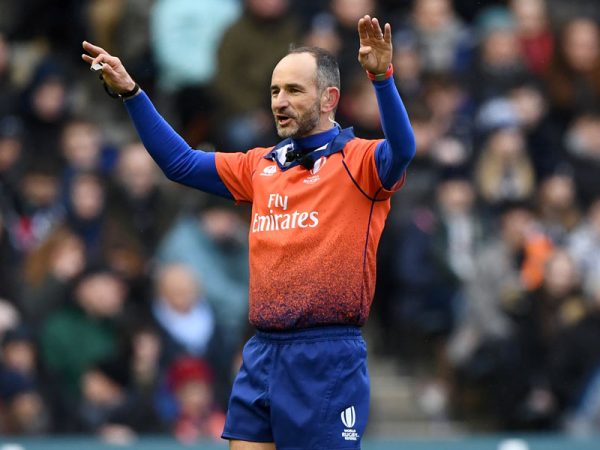What exactly does a TMO do? Read our basic guide about the match official you never see but who plays a vital part in ensuring the on-field referee makes good decisions
TMO – television match official explained
What is a TMO in rugby?
The acronym stands for television match official. The TMO is someone who watches the match action on TV screens, usually in a truck outside the ground. Using a system called Hawk-Eye, they can see multiple camera angles of an incident and pass on information to the match referee – via an earpiece – to help him make accurate decisions.
Can the TMO intervene on any matter they like?
No, the TMO in rugby is basically restricted to two crucial areas:
1. The scoring of a try, whether the grounding of the ball or the build-up to the try. Any infringement within the two phases prior to a try would render it illegal.
A referee can also use the TMO’s help to ascertain whether a kick went between the posts, but that’s quite a rare occurrence.
2. Possible foul play. The TMO is free to communicate with the referee at any time if he sees something he suspects is foul play. Equally, the referee can ask the TMO to look at an incident, either while the game continues or after stopping play.

Strong signal: referees can draw a box to signify to the crowd that a decision has gone to the TMO (Getty)
Doesn’t it hold the game up?
Yes. But efficient use of the TMO system has improved over the years. Referees have been encouraged to refer fewer decisions ‘upstairs’ in a bid to reduce the interruptions.
Usually the footage is shown on a big screen inside the ground. If he likes, the referee can make a quick decision himself, without waiting to hear what the TMO has to say.
World Rugby spell out in their laws that “the referee should not be subservient to the system” and that he is “the decision-maker and must remain in charge of the game”.
Generally what happens is that the referee will relay “what I’m seeing” to the TMO, who will agree with him. The decision is made and the game resumes.
But there are instances of TMOs trying to persuade a referee to change his mind. If they say “Would you like to look at it again?”, it suggests they think the ref has made the wrong call. And if they say “Those are all the angles”, it means they’re not sure so it’s over to you, ref!

Hideaway: this is the sort of place you’ll find the TMO at work, well away from prying eyes! (Sky Sports)
Can they watch the video footage as many times as they like?
Strictly speaking yes, but this is entering murky waters. Some TMOs still seem unwilling to back their judgment until they’ve seen about ten replays! The key is that if a referee is seeking clarification that his initial decision can stand, the decision should only be reversed on TMO referral if the evidence is “clear and obvious”.
Thus, for example, a possible forward pass shouldn’t lead to a try being disallowed if the direction of the pass is too borderline to call one way or the other. Just award it and play on.
Men’s Six Nations Fixtures
The 2025 Guinness Men’s Six Nations fixtures kicked…
Six Nations table: the latest standings in the championship
The 2025 tournament is now over but how…
Six Nations referees 2025: Who’s taking charge of this year’s championship matches?
Who are the referees, assistants and TMOs for…
Has the TMO made the game better?
Most people think so. The system first appeared, in a very basic form, in 1999 and it’s taken a while to iron out the creases. The England-Fiji game that opened the 2015 World Cup rankled because 28% of the stoppage time was for TMO reviews.
But the rationale behind it is to reduce or eradicate blatant injustices. Such as the try Wales’ Mike Phillips scored from a quick lineout against Ireland in 2011. Replays showed that the ball used by thrower Matthew Rees had been handed to him by a ballboy – which made a quick lineout illegal. But the try stood and Wales won 19-13.
Another bone of contention is slow-motion replays, which invariably make an incident look worse than it actually was. Five years ago England’s James Haskell complained about this after being sin-binned for a high tackle against Ireland.

Off you go! Romain Poite sends James Haskell to the sin-bin in 2016 following a high tackle (Getty)
“Reviewing incidents is a good idea but playing it on the big screen, making it a big circus, is not constructive,” he said. “I think the referee, or the people who are making the judgment, should do it away from the big screen. I don’t know why it is made a spectacle.”
Related content: Laughs aplenty in James Haskell’s new book
Certainly referees can be put under far more pressure to act by the aggressive reaction of a home crowd that watches an incident involving a visiting player on the big screen. The same offence by a home player might produce little more than a murmur!
Don’t football have a TMO now?
Yes, of sorts. They call their system VAR (Video Assistant Referee) and it’s already been branded a “shambles” by Alan Shearer.
Football will find their use of it improves with time. But the cynical nature of top-level football – for example, attackers seeking contact in order to win a penalty – means disputes about decisions in the round-ball code will rage on and on!

All-seeing: there are over 20 TV cameras at big games – but it still comes down to opinions (Sky Sports)
Follow Rugby World on Facebook, Twitter and Instagram








